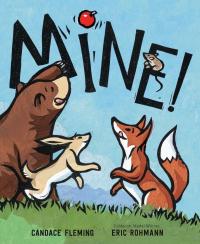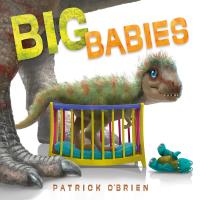
When snow starts falling, the perfectly normal animals on Farmer Pumpernickel’s farm start acting strangely; they catch snowflakes on their tongues! Eventually, even the farmer himself gets with the rhythm. Rhyming text accompanied by comical illustrations will make a joyful read aloud.
Snowflakes on Our Tongues

What happens when round-headed kids are asked to play with triangles, rectangles, and other shapes. Can they come up with something entirely new? Where else can these shapes be found? The simple comic format and straightforward art are ideal in showing shapes all around and may lead to hands-on activities with more shapes.
Shapes and Shapes

A girl thinks everyone else in her family is smarter and more talented that she is. The girl thinks she messes up whatever she touches, even her grandmother’s nesting dolls. Her wise grandmother helps her understand that not all family members have the same gifts or look alike, but each is an important part of the same family. The author explores her own Gullah Geechee background in this touching and universal story.
Nesting Dolls

One single red apple hangs on a tree. One by one, animals see it and greedily declare it “Mine!” Only a nonplussed possum willing to share it with the apple’s resident worm winds up with the prize. Alliterative, animated, onomatopoeic language is paired with strong lines and color for a jaunty, delightful book to read aloud.
Mine!

Micah knows that his new sister Lily is a Martian. His fears are confirmed by his cousin Maxwell and doubly so when Lily goes to school with Micah for show-and-tell! Humor abounds in this out-of-this-world sibling story.
Invader from Mars: The Truth About Babies

Readers are asked to count to one. Just one elephant. Just one sausage (on a whale’s spout, with a second whale nearby). Just one fly (atop 3 bowls of soup). Sly humor on each colorful page will have young readers chortling and counting beyond just one!
How to Count to 1

A boy, his dog, and elephant set out to find Dinosaur in the big city. One must be very observant! Readers will quickly see Dinosaur on every page long before the boy does. The gentle watercolor illustrations are filled with humorous details of ubiquitous dinos and onlookers surprised to see an elephant with the boy and his dog. This is a clever follow-up to Barrow’s equally engaging, Have You Seen Elephant? (opens in a new window).
Have You Seen Dinosaur?

Together Gift and Box were a package on the way to a child from her grandmother. “Gift’s purpose was to delight. Box’s purpose was to protect.” They both arrived safely, and brought joy to the young Sofia! Imaginative illustrations on what appears to be cardboard depict packages’ long journey in an amusing, reassuring way.
Gift & Box

Doris, a performing horse, steps out of her comfort zone to find out what is twinkling beyond. She feels the “moonness” and soon is joined by a brown pony and together they dance off. Swirling illustrations combine with limited text that whirls across the pages in this joyful celebration.
Doris

Will JoJo ever be able to dance the national dance of the Philippines as easily as his grandmother? As he watches and practices, he begins to learn how to let the rhythm move through him and he dances the tininkling! Warm illustrations complement the lively text, evoking the sense of movement and joy.
Dancing the Tinikling

Dance along with the residents of an apartment building: reggaeton, salsa, tango, and more! Jaunty language and bright, naive-style illustrations make music of their own, but also can be heard or watched via video when linked to the accompanying website.
Boogie in the Bronx

Brief information is placed on open pages with lots of white space to highlight portraits of baby dinosaurs that are seriously cute and seriously funny. The baby T-rex — “tyrant lizard king“ — is placed in a bejeweled royal crown, with a partial view of a huge parent looking down at the fuzzy baby. Additional information and comparative size chart conclude this informative, amusing book.
Big Babies

Folk art and crisp language introduce the human heart to readers (along with some interesting tidbits about other creatures’ hearts). Accessibly written by a pediatric cardiologist, this handsome book can be read from cover to cover or dipped in and out of.
All About the Heart

Will the runaway pea become a snack for one of the animals it rolls by? Illustrations call to mind folk art in this rollicking translation from the French. The tale is likely to hold up to multiple readings and may inspire young gardeners!
Roll, Roll, Little Pea

Short, mostly familiar rhymes and lullabies are gently illustrated by textured embroidered images, just right to remind adults of the power of short rhymes meant to be shared with the youngest.
Read to Your Baby Every Night

A small dog and tiny cat are best of friends, playing all day, until one day Tao is hurt. George misses Tao very much until the friends are reunited, one with a bandage and gentler play. Simple but evocative illustrations complement the effective, brief narrative.
George & Tao

Tired of the same Old MacDonald’s farm? Add donuts and a greedy crocodile alongside a take-charge rooster and it’s a new tune! Silliness is the word (and picture) on this farm as children will sing along with the rousing E-I-E-I-O!
Croc-a-Doodle Doo!

Budding backyard scientists can start exploring their world with this stunning introduction to these flowery show-stoppers — from seeds to roots to blooms. Learning how flowers grow gives kids beautiful building blocks of science and inquiry.
What’s Inside a Flower?

Meet seeds that pop, hop, creep, and explode in this vividly illustrated introduction to the simplest concepts of botany. Learn about the many ways that seeds get from here to there, engaging children’s curiosity with strong action verbs. Clear photographs with fact-packed captions provide supporting details, explaining the role of seed features and functions in creating new generations of plants. Concludes with an illustrated glossary and back matter featuring more resources.
A Seed Is the Start

How many people actually know where chocolate comes from? How it’s made? Or that monkeys do their part to help this delicious sweet exist? Kids will learn that chocolate comes from cocoa beans, which grow on cocoa trees in tropical rain forests. But those trees couldn’t survive without the help of a menagerie of rain forest critters: a pollen-sucking midge, an aphid-munching anole lizard, brain-eating coffin fly maggots — they all pitch in to help the cocoa tree survive. Two wise-cracking bookworms appear on every page, adding humor and further commentary, making this book accessible to readers of different ages and reading levels.
No Monkeys, No Chocolate

In Manu National Park in Peru, an amazing fourteen different species of monkeys live together. That’s more than in any other rainforest in the world! How can they coexist so well? Find out in this lyrical, rhyming picture book that explores each monkey’s habits, diet, and home, illustrating how this delicate ecosystem and its creatures live together in harmony. From howler monkeys to spider monkeys to night monkeys, young readers will love getting to know these incredible primates and seeing the amazing ways they share their forest.
Fourteen Monkeys

With the soothing rhythm of a bedtime story and the scientific wonder of a nature documentary, comes a celebration of the moon and all the creatures who rely on its light to find their way home. Under the glow of a shimmering moon, creatures great and small creep out of their dens, using its light to hunt, fend off predators, build their nests or build families. As the moon changes phases these animals adapt their behavior to match its waxing and waning — while human animals look on in wonder.
Thank You, Moon

This is a book about dinosaurs. No it’s not. Dinosaurs are not allowed. Oh. This is now a book about avocados! Sorry. We deleted those too. Discover just what can happen when ideas are erased instead of expressed with this hilarious picture book romp that kids (and grown-ups) will want to read over and over again.
This Book Is Banned

Alice loves to imagine herself in the magical pages of her favorite book. So when it flaps its pages and invites her in, she is swept away to a world of wonder and adventure, riding camels in the desert, swimming under the sea with colorful fish, floating in outer space, and more! But when her imaginative journey comes to an end, she yearns for the place she loves best of all.
